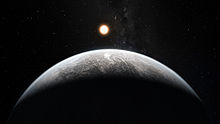HD 85512
| Observation data Epoch J2000 Equinox J2000 | |
|---|---|
| Constellation | Vela |
| Right ascension | 09h 51m 07.0520s[1] |
| Declination | −43° 30′ 10.0220″[1] |
| Apparent magnitude (V) | 7.66 |
| Characteristics | |
| Spectral type | K6V[2] |
| U−B color index | 1.12 |
| B−V color index | 1.18 |
| V−R color index | 0.71 |
| Astrometry | |
| Radial velocity (Rv) | −9.6 km/s |
| Proper motion (μ) | RA: 461.446±0.103[1] mas/yr Dec.: −472.010±0.116[1] mas/yr |
| Parallax (π) | 88.6158 ± 0.0406 mas[1] |
| Distance | 36.81 ± 0.02 ly (11.285 ± 0.005 pc) |
| Absolute magnitude (MV) | 7.39[3] |
| Details[2][4] | |
| Mass | 0.69 M☉ |
| Radius | 0.533 ± 0.04[note 1] R☉ |
| Luminosity (bolometric) | 0.126 ± 0.008 L☉ |
| Surface gravity (log g) | 4.604±0.017 cgs |
| Temperature | 4404±10 K |
| Metallicity | ([Si/H] dex) -0.02 |
| Metallicity [Fe/H] | -0.28 dex |
| Rotation | 47.13 ± 6.98 |
| Rotational velocity (v sin i) | 2.194±0.118 km/s |
| Age | 5.61 ± 0.61 Gyr |
| Other designations | |
| Database references | |
| SIMBAD | data |
HD 85512 is a solitary K-type main-sequence star about 37 light-years away in the constellation Vela. It is about 1 billion years older than the Sun. It is extremely chromospherically inactive, only slightly more active than Tau Ceti. It exhibits a long-term variability[2] and is known to host one low-mass planet.
Planetary system

On August 19, 2011, a ≥3.6 Earth-mass planet was discovered using HARPS that is "just inside" the habitable zone, along with: inner planets of e (or 82 G.) Eridani; and HR 7722 c in Capricornus. These two comparator sets are at about 2⁄3 of the subject's distance from Earth.[7] The subject planet could be cool enough to host liquid water if it has more than 50% cloud coverage. For a time it ranked fifth-best for habitability in the Habitable Exoplanets Catalog, which later lists it under false starts as "too hot".[8]
| Companion (in order from star) |
Mass | Semimajor axis (AU) |
Orbital period (days) |
Eccentricity | Inclination | Radius |
|---|---|---|---|---|---|---|
| b | ≥3.6 M🜨 | 0.26 ± 0.005 | 58.43 ± 0.13 | 0.11 ± 0.1 | — | — |
Position
The star lies in Vela, 3′32″ west of, and 10′54″ north of LZ Velorum (HD 86005), a chromospherically active giant, variable star, at 2090 light years away, of orange-to-red color. It has similar average magnitude.[9]
References
- ^ a b c d e Brown, A. G. A.; et al. (Gaia collaboration) (August 2018). "Gaia Data Release 2: Summary of the contents and survey properties". Astronomy & Astrophysics. 616. A1. arXiv:1804.09365. Bibcode:2018A&A...616A...1G. doi:10.1051/0004-6361/201833051. Gaia DR2 record for this source at VizieR.
- ^ a b c Anglada-Escudé, Guillem; Butler, R. Paul (2012), "The HARPS-TERRA project. I. Description of the algorithms, performance, and new measurements on a few remarkable stars observed by HARPS", The Astrophysical Journal Supplement Series, 200 (2): 15, arXiv:1202.2570, doi:10.1088/0067-0049/200/2/15, S2CID 118528839
- ^ Holmberg, J.; et al. (July 2009), "The Geneva-Copenhagen survey of the solar neighbourhood. III. Improved distances, ages, and kinematics", Astronomy and Astrophysics, 501 (3): 941–947, arXiv:0811.3982, Bibcode:2009A&A...501..941H, doi:10.1051/0004-6361/200811191, S2CID 118577511.
- ^ Spectroscopic Parameters and atmosphEric ChemIstriEs of Stars (SPECIES) I. Code description and dwarf stars catalogue Full table D.1
- ^ "HD 85512". SIMBAD. Centre de données astronomiques de Strasbourg. Retrieved 2019-09-22.
- ^ "Fifty New Exoplanets Discovered by HARPS". ESO Science Release. 12 September 2011. Retrieved 13 September 2011.
- ^ a b Pepe, F.; et al. (2011). "The HARPS search for Earth-like planets in the habitable zone. I. Very low-mass planets around HD 20794, HD 85512, and HD 192310". Astronomy and Astrophysics. 534. A58. arXiv:1108.3447. Bibcode:2011A&A...534A..58P. doi:10.1051/0004-6361/201117055.
- ^ http://phl.upr.edu/library/notes/falsestarts
- ^ https://www.universeguide.com/star/48598/lzvelorum
Notes
- ^ From , where is the radius, is the luminosity, is the effective surface temperature and is the Stefan–Boltzmann constant.
External links





